
Wine Culture and Information since 2002 - Volume 22
 Wine Culture and Information since 2002 - Volume 22 |
|
Issue 159, February 2017 |
Contents |
|
|
A New Wine Law in Italy |
|
«Wine, a product from the vine, vine and territories, fruit of work, the sum of competences, knowledge, practices and traditions, is a national cultural heritage to be safeguarded and promoted about the aspects of social, economic, productive, environmental and cultural sustainability.» This is the first article of the so called Testo Unico del Vino (literally “Single Wine Text”), the new Italian law having the function of regulating and safeguarding Italian wine. Moreover, the goal is also to simplify and decrease bureaucratic obligations to which wine producers must obey to. With this first article, wine is recognized as a “cultural national heritage”, therefore something to be safeguarded, an identifying element of Italy. The new law, which will also have the function of regulating wine production in Italy, consists of 91 articles, of which the last one has the purpose of repealing the previous laws. The goal, ambitious and praiseworthy in the intentions of legislators - that is to simplify and decrease bureaucratic obligations to producers - is evidently positive and wished. Time will tell whether they reached this goal or not, for the moment, comments of wine professionals seem to be positive. It seems both legislators and wine associations have expressed - in general terms - positive comments about the so called “Testo Unico del Vino” and it seems everyone is happy about it. So far, so good. This time, it seems everyone is happy. If we consider the not so positive comments about past laws and regulations about wine production, the fact everyone is happy with this new law is, as a matter of fact, breaking news. Wine producers, thanks to this law, will in fact have a single legal text to be used for their job and to safeguard their wines. Indeed, not all seem to have positively welcome the Testo Unico del Vino. Some producers, in particular small ones, say what they did with the Testo Unico del Vino was to put different laws in a single document. Moreover, others say the goal of simplifying bureaucratic obligations is pretty questionable, as they believe the new law has indeed introduced an even increased bureaucratic obligation. From their point of view, their complains are quite understandable. Small producers represent particular enterprise cases in which, for practical reasons and for a matter of fact, they need to take care of any activity about their winery. This means, of course, they must fulfill both the fundamental viticultural and wine making role - that is, the core business of their job - as well as the bureaucratic and fiscal obligations set by the laws. The consideration is of course simple: the time a small producer spends on bureaucratic obligations - who lives in a world made of 24 hours, just like everyone of us - is subtracted to the time he needs to spend on the fundamental viticultural activity. And in case wine production is neglected, or the wine ends up being less good because of this, the understandable and legitimate profit is compromised. Whoever makes wine or is in the field of the beverage of Bacchus, knows very well when there is the need of working in the vineyard or in the winery, it is fundamental to do that without any delay. Being late in properly treating the vineyard, harvesting grapes or taking care of the wine, even of a single day, may change, even drastically, the fate and quality of wine. As a matter of fact, being late in bureaucratic obligations also brings to pretty serious consequences, including penalties provided by the law. What if a bureaucratic obligation is due the same day a vintner needs to take care of the vineyard or wine? The small “factotum” producer must reconcile both things - and very quick - or take the risk to accept a compromise. I have been told about these considerations, like to say, of pretty practical nature, by many owners of small viticoltural businesses, those which could be defined small producers. These producers have basically expressed the very same considerations and all of them have emphasized the fact they do not want to neglect their legal obligations. The condition of running and managing the winery by themselves - or, in case they can, with the help of family members - also includes the time and attention they need to give to bureaucratic obligations. For the sake of clearness, it should said these legal obligations have the purpose of preventing certain frauds, therefore playing a fundamental role in safeguarding wine. However, the need of taking note or recording many times the same information, or to send the same document to many institutions, seems to be a waste of time which could be of course avoided. The professional associations about wine seems to deny the considerations of certain producers, while supporting the fact Testo Unico del Vino introduces substantial simplification and a drastic decrease of bureaucratic obligations. It is not so easy to tell who is right, maybe it is just a matter of point of views or the skill and possibility of properly managing one's job and time. Including the possibility of delegating to others some duties or obligations, something that - of course - cannot be afforded by everyone. However, the issuing of Testo Unico del Vino is an event that, in overall terms, can be positively welcome. Nevertheless, the fact of having grouped many laws in a single document therefore offering to producers a unique reference for their job. Time will tell whether this law has really simplified the life and job of wine producers. Let's hope rumors and premises which preceded the issuing of Testo Unico del Vino, including all the expectations, really made a difference in introducing a positive change which will be beneficial, in particular, to Italian wine. Antonello Biancalana
|
||||
Contrasts of Viognier and Trebbiano SpoletinoRhône Valley and Umbria compared in our glasses with two grapes having a different character and capable of making wines of remarkable elegance and personality |
|
The tasting by contrast of this month will be about white wines again and we will examine two very interesting varieties, capable of making wines of remarkable personality and finesse. Viognier and Trebbiano Spoletino are the protagonists of our tasting by contrast which will be compared in our glasses. Grapes of uncertain origin - for both, in fact, there is no sure evidence about their origin - they however share the same destiny. Viognier and Trebbiano Spoletino have both been forgotten in the past by producers for a very long time, therefore reevaluated and brought to success again. A reevaluation happened in relatively recent times - about twenty years ago - which allowed both grapes to become extraordinarily successful while becoming popular varieties in their respective territories while conquering the fame even beyond the borders of their lands. This happened, in particular, for Viognier which, besides being appreciated outside the borders of its original land, it has also been successful in catching the attention of many vintners in the world. Grapes having a remarkable wine making appealing, they are particularly famous for their elegant wines having a strong personality. Both varieties seem to share the same wine making versatility: they are in fact used for the production of table and sparkling wines as well as sweet wines made from dried grapes. Even wine making practices seem to have many things in common as producers usually vinify both grapes in inert containers - steel tanks, in particular - while avoiding the use of wood, therefore cask. The reason is mainly determined by the fact, in both cases, producers tend to favor the aromatic expression of the grapes, a very important characteristic both for Viognier and Trebbiano Spoletino.
|
|
Viognier is known for being the protagonist of Condrieu wines, an Appellation d'Origine Contrôlée of France and belonging to the Rhône Valley territory. This variety is also famous for the wines produced in the smallest appellation of France and corresponding exactly to the estate of a single producer: Château-Grillet. This estate covers an area of about 3.5 hectares (about 9 acres) and, as a matter of fact, is an enclave of Condrieu appellation, both belonging to the larger Rhône Valley AOC. The success of Viognier - capable of making elegant wines with good aromas - caught the attention of producers in other countries and today this variety is considered as an international grape. It should be said wines produced with Viognier are quite prone to oxidation, therefore their consumption is generally recommended during their youth. In this way, in fact, Viognier can express its best aromatic potentials in which it is possible to perceive tropical fruits, apricot and even violet. The origin of Viognier, including the origin of its name, is quite uncertain. The most supported theory wants this variety coming from Dalmatia - in the modern Croatia - introduced in the Condrieu territory by ancient Romans. Indeed, there are many theories about the origin of Viognier and its presence in Condrieu, most of them sounding like legends or work of fantasy. The origin of the name is uncertain as well. Some support the idea Viognier comes from the name of French city Vienne, for others it comes from Gehennae - the place where, according to the New Testament, sinners were burned by fire, therefore meaning the hell - because of the supposed difficulty in cultivating this grape. After having faced a concrete risk of extinction - in 1965 there were a little less than 9 hectares in total - today it is widely appreciated and cultivated in the world. It should be finally noted a research done in 2004 on Viognier's DNA discovered a close connection to Freisa - a red grape from Piedmont, Italy - therefore introducing the hypothesis of the origin within the territory of Alps.
|
||||
|
Rising glory of the Viticulture of Umbria, in the last recent years Trebbiano Spoletino got more and more successful thanks to the quality of its wines. This interesting grape is cultivated since remote times in the territory going from Trevi - a village not so far from Foligno - passing through Montefalco up to reaching Spoleto, the town from which Trebbiano Spoletino is named after. In past times, Trebbiano Spoletino was cultivated with the technique called vite maritata (literally, married vine), that is by allowing vines to climb on living trees. This technique, notoriously of Etruscan origin, was widely used in past centuries and even today, in Umbrian countryside, it is possible to see century-old Trebbiano Spoletino vines climbing on living trees. These special Trebbiano Spoletino vines - tens of years old - are capable of making wines of extraordinary finesse and longevity, expressing an organoleptic profile of sumptuous complexity associated to body and elegance. The origin of Trebbiano Spoletino is uncertain and even historical information about this variety are pretty scarce. There are mentions about the wines of Spoleto since remote times, in particular thanks to the writings of Pliny the Elder and Martial, who praised the golden color of the wines made in this area as well as their high quality. However, it is quite hard to tell whether they were referring to Trebbiano Spoletino or not. We have the first mention of this grape in 1878 thanks to Francesco Francolini - headmaster of the itinerant agriculture teaching post of Spoleto - in his “Bollettini Ampelografici” (Ampelography Bulletins). In 1908 Francesco Francolini mentions Trebbiano Spoletino again in his work “La Valle Spoletina e le sue condizioni Economiche-Agricole”) (The Valley of Spoleto and its Economic-Agricultural Conditions), praising the quality of its wines, including sparkling wines. The name could make one think the grape belongs to the vast family of Trebbiano, indeed Spoletino has no connection to these grapes including the usual etymology of the term. It is in fact believed the name Trebbiano associated to Spoletino comes from Trevi - a village between Foligno and Spoleto - therefore meaning grape from Trevi and supporting the idea this village is the native place of this interesting Umbrian white grape.
|
|
The wine we will choose for our tasting by contrast will examine wines made with 100% Viognier and Trebbiano Spoletino. As for Viognier, we will choose a wine belonging to the Appellation d'Origine Contrôlée Condrieu, which can be exclusively produced with variety only. The choice becomes a little more difficult for Trebbiano Spoletino. This variety is used for wines named after this grape and belonging to Denominazione d'Origine Controllata Spoleto, in which can be used a minimum quantity of 85%. Trebbiano Spoletino is also used in wines belonging to Indicazione Geografica Tipica Umbria, therefore we can also choose a wine made outside the territory of Spoleto. In both cases we will choose young wines - therefore being not more than two years old - and produced in inert containers. Our Viognier and Trebbiano Spoletino will be served at the temperature of 10 °C (50 °F) and poured in tasting glasses.
Let's start the tasting our white wines and pour them in their respective glasses. The first organoleptic aspect we are going to evaluate is - of course - appearance, that is color and transparency. Let's start from Viognier and tilt the glass on a white surface. We will observe the base of the glass, where the liquid mass is thicker, and evaluate color. Viognier shows a brilliant greenish yellow color and a high transparency: it is perfectly possible to see the object put between the glass and the white surface. Nuances, observed at the edge of the wine near the opening of the glass, confirm the same color. Let's now pass to the evaluation of Trebbiano Spoletino and tilt the glass on the white surface. The color of the wine from Umbria shows an evidently darker and deeper hue than Viognier: here can be clearly seen an intense straw yellow color, even gold yellow. with a high transparency. Nuances, observed near the opening of the glass, confirm the same color. The olfactory profiles of Viognier and Trebbiano Spoletino give the nose of the taster interesting aromas, for certain aspects, even surprising. Both grapes make in fact wines with a remarkable aromatic elegance and, on this regard, we should notice neither Viognier nor Trebbiano Spoletino are aromatic varieties. Viognier, in particular the one produced in Condrieu, gives aromas recalling peach, apricot and citrus fruits, as well as tropical fruits - mango in particular - and an aroma we would not expect in a white wine: violet. With time, Viognier can develop aromas of musk, tobacco and spices, in particular ginger. Trebbiano Spoletino is nothing less. The white from Umbria is capable of expressing aromas of remarkable elegance in which can be perceived melon, medlar, peach, kiwi and citrus fruits, as well as aromas of tropical fruits such as lychee. In certain cases, in Trebbiano Spoletino can be perceived the aroma of hazelnut as well as mineral sensations. Let's evaluate the olfactory profiles of the wines of our tasting by contrast from the glass of Viognier. Let's hold the glass in vertical position and, without swirling, we will do the first smell in order to perceive opening aromas. Viognier gives the nose aromas of peach, apricot, pear and - in case we opted for a Condrieu wine - we can perceive a pleasing aroma of violet. After having swirled the glass, the profile of Viognier is completed by pineapple, mango, apple, acacia, broom and banana. Let's now pass to the olfactory evaluation of Trebbiano Spoletino, by starting from the examination of opening aromas. From the glass, held in vertical position and without swirling, will be perceived pleasing aromas of apple, medlar, peach and citrus fruits, frequently recalling grapefruit. After having swirled the glass, let's do a second smell which will complete the profile of Trebbiano Spoletino with melon, kiwi, lychee, hawthorn and pear to which could follow the aromas of hazelnut and mineral. We will now compare the two glasses: differences of the respective profiles are evident and well recognizable. After having evaluated the olfactory profiles of both wines, let's now taste them in order to understand gustatory differences. Just like the previous phases, we will start the evaluation from Viognier. The attack of this wine is characterized by a pleasing crispness and the pseudo-burning sensation of alcohol is moderate, however enough to balance the wine. In the mouth is perceived a good structure with the flavors of peach, apricot and mango confirming what was already perceived to the nose. Let's now take a sip of Trebbiano Spoletino and evaluate its attack. In the mouth is perceived an intense crispness and the pseudo-burning effect of alcohol is more intense than Viognier, also in this case enough to make the wine balanced. The structure of the Umbrian wine is clearly perceptible as well as the pleasing sensation of roundness. In the mouth are perceived flavors of medlar, apple, peach and a pleasing sensation recalling citrus fruits. In the last phase of our tasting by contrast we will examine the sensations left in the mouth by the wines after having swallowed them. The finish of Viognier is characterized by a good persistence in which are clearly perceived the flavors of apricot, peach and mango, as well as the acidity's crispness. The finish of Trebbiano Spoletino is persistent as well, in which are perceived flavors of peach, apple and medlar, sometime pineapple too. The sensation left in the mouth by the white from Umbria is characterized both by acidity's crispness and the good sensation of body. On this regard, Trebbiano Spoletino seems to have a fuller body than Viognier and the pseudo-burning sensation caused by alcohol is more intense. The two grapes of our tasting by contrast both reveal personality and character, developing from the respective glasses an elegant class and finesse.
|
||||||||
Wines of the Month |
|
|
|
Score legend Prices are to be considered as indicative. Prices may vary according to the country or the shop where wines are bought |
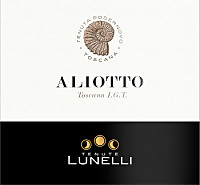
|
|
Aliotto 2014 |
|
| Tenuta Podernovo (Tuscany, Italy) | |
 Sangiovese (60%), Cabernet Sauvignon, Cabernet Franc, Merlot, Other Grapes (40%) Sangiovese (60%), Cabernet Sauvignon, Cabernet Franc, Merlot, Other Grapes (40%) | |
| Price: € 10.00 | Score: |
 Brilliant ruby red and nuances of ruby red, moderate transparency. Brilliant ruby red and nuances of ruby red, moderate transparency. Intense, clean, pleasing and refined, starts with hints of plum, black
cherry and black currant followed by aromas of dried violet, blueberry,
vanilla and chocolate. Intense, clean, pleasing and refined, starts with hints of plum, black
cherry and black currant followed by aromas of dried violet, blueberry,
vanilla and chocolate.
 Properly tannic attack and however balanced by alcohol, good body,
intense flavors, agreeable. Properly tannic attack and however balanced by alcohol, good body,
intense flavors, agreeable.
 Persistent finish with flavors of black cherry, plum and black currant. Persistent finish with flavors of black cherry, plum and black currant. 12 months in barrique, 4 months in bottle. 12 months in barrique, 4 months in bottle. |
|
 Stuffed pasta with mushrooms, Broiled meat and barbecue, Stewed meat with mushrooms Stuffed pasta with mushrooms, Broiled meat and barbecue, Stewed meat with mushrooms |
|
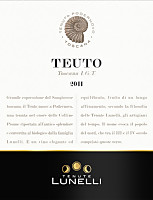
|
|
Teuto 2012 |
|
| Tenuta Podernovo (Tuscany, Italy) | |
 Sangiovese (95%), Merlot (5%) Sangiovese (95%), Merlot (5%) | |
| Price: € 16.00 | Score: |
 Intense ruby red and nuances of garnet red, moderate transparency. Intense ruby red and nuances of garnet red, moderate transparency. Intense, clean, pleasing and refined, starts with hints of black
cherry, plum and raspberry followed by aromas of violet, blueberry,
vanilla, tobacco, chocolate, pink pepper and menthol. Intense, clean, pleasing and refined, starts with hints of black
cherry, plum and raspberry followed by aromas of violet, blueberry,
vanilla, tobacco, chocolate, pink pepper and menthol.
 Properly tannic attack and however balanced by alcohol, good body,
intense flavors, pleasing crispness. Properly tannic attack and however balanced by alcohol, good body,
intense flavors, pleasing crispness.
 Persistent finish with flavors of black cherry, plum and raspberry. Persistent finish with flavors of black cherry, plum and raspberry. 24 months in cask, 12 months in bottle. 24 months in cask, 12 months in bottle. |
|
 Broiled meat and barbecue, Roasted meat, Stewed meat with mushrooms, Hard cheese Broiled meat and barbecue, Roasted meat, Stewed meat with mushrooms, Hard cheese |
|
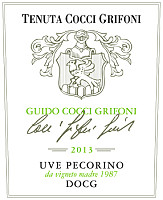
|
|
Offida Pecorino Guido Cocci Grifoni 2013 |
|
| Tenuta Cocci Grifoni (Marches, Italy) | |
 Pecorino Pecorino | |
| Price: € 26.00 | Score: |
 Intense straw yellow and nuances of straw yellow, very transparent. Intense straw yellow and nuances of straw yellow, very transparent. Intense, clean, pleasing, refined and elegant, starts with hints of
apple, peach and medlar followed by aromas of pear, hawthorn, plum,
hazelnut, grapefruit, pineapple, broom, bergamot, marjoram and mineral. Intense, clean, pleasing, refined and elegant, starts with hints of
apple, peach and medlar followed by aromas of pear, hawthorn, plum,
hazelnut, grapefruit, pineapple, broom, bergamot, marjoram and mineral.
 Crisp attack and however balanced by alcohol, good body, intense
flavors, pleasing roundness. Crisp attack and however balanced by alcohol, good body, intense
flavors, pleasing roundness.
 Very persistent finish with very long flavors of apple, peach, plum and
medlar. Very persistent finish with very long flavors of apple, peach, plum and
medlar.
 18 months in steel tanks, at least 6 months in bottle. 18 months in steel tanks, at least 6 months in bottle. |
|
 Stuffed pasta, Roasted fish, Roasted white meat, Mushroom soups Stuffed pasta, Roasted fish, Roasted white meat, Mushroom soups |
|
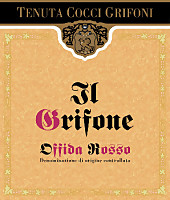
|
|
Offida Rosso Il Grifone 2010 |
|
| Tenuta Cocci Grifoni (Marches, Italy) | |
 Montepulciano (70%), Cabernet Sauvignon (30%) Montepulciano (70%), Cabernet Sauvignon (30%) | |
| Price: € 18.00 | Score: |
 Deep ruby red and nuances of garnet red, little transparency. Deep ruby red and nuances of garnet red, little transparency. Intense, clean, pleasing, refined and elegant, starts with hints of
black cherry, plum and black currant followed by aromas of blueberry, dried
violet, blackberry, vanilla, leather, tobacco, chocolate, graphite, mace
and menthol. Intense, clean, pleasing, refined and elegant, starts with hints of
black cherry, plum and black currant followed by aromas of blueberry, dried
violet, blackberry, vanilla, leather, tobacco, chocolate, graphite, mace
and menthol.
 Tannic attack and however balanced by alcohol, full body, intense
flavors, pleasing roundness. Tannic attack and however balanced by alcohol, full body, intense
flavors, pleasing roundness.
 Very persistent finish with long flavors of black cherry, plum and
black currant. Very persistent finish with long flavors of black cherry, plum and
black currant.
 30 months in cask, at least 6 months in bottle. 30 months in cask, at least 6 months in bottle. |
|
 Game, Roasted meat, Stewed and braised meat, Hard cheese Game, Roasted meat, Stewed and braised meat, Hard cheese |
|
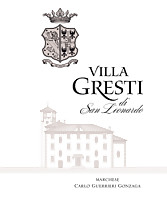
|
|
Villa Gresti 2011 |
|
| Tenuta San Leonardo (Trentino, Italy) | |
 Merlot (90%), Carménère (10%) Merlot (90%), Carménère (10%) | |
| Price: € 30.00 | Score: |
 Intense ruby red and nuances of garnet red, little transparency. Intense ruby red and nuances of garnet red, little transparency. Intense, clean, pleasing, refined and elegant, starts with hints of
black cherry, black currant and blueberry followed by aromas of plum,
violet, raspberry, vanilla, chocolate, face powder, tobacco, iris and
eucalyptus. Intense, clean, pleasing, refined and elegant, starts with hints of
black cherry, black currant and blueberry followed by aromas of plum,
violet, raspberry, vanilla, chocolate, face powder, tobacco, iris and
eucalyptus.
 Proper tannic attack and however balanced by alcohol, full body,
intense flavors, pleasing roundness. Proper tannic attack and however balanced by alcohol, full body,
intense flavors, pleasing roundness.
 Persistent finish with flavors of black cherry, black currant and plum. Persistent finish with flavors of black cherry, black currant and plum. 14 months in barrique, 12 months in bottle. 14 months in barrique, 12 months in bottle. |
|
 Game, Roasted meat, Stewed and braised meat, Hard cheese Game, Roasted meat, Stewed and braised meat, Hard cheese |
|
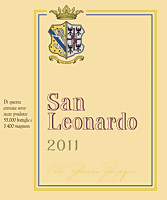
|
|
San Leonardo 2011 |
|
| Tenuta San Leonardo (Trentino, Italy) | |
 Cabernet Sauvignon (60%), Carménère (20%), Cabernet Franc (10%), Merlot (10%) Cabernet Sauvignon (60%), Carménère (20%), Cabernet Franc (10%), Merlot (10%) | |
| Price: € 50.00 | Score: |
 Intense ruby red and nuances of garnet red, little transparency. Intense ruby red and nuances of garnet red, little transparency. Intense, clean, pleasing, refined and elegant, starts with hints of
black currant, black cherry and blueberry followed by aromas of plum,
violet, raspberry, vanilla, iris, chocolate, tobacco, green bell pepper,
coriander, pink pepper, mace and eucalyptus. Intense, clean, pleasing, refined and elegant, starts with hints of
black currant, black cherry and blueberry followed by aromas of plum,
violet, raspberry, vanilla, iris, chocolate, tobacco, green bell pepper,
coriander, pink pepper, mace and eucalyptus.
 Tannic attack and however balanced by alcohol, full body, intense
flavors, agreeable. Tannic attack and however balanced by alcohol, full body, intense
flavors, agreeable.
 Very persistent finish with long flavors of black currant, black cherry
and blueberry. Very persistent finish with long flavors of black currant, black cherry
and blueberry.
 24 months in barrique, 12 months in bottle. 24 months in barrique, 12 months in bottle. |
|
 Game, Roasted meat, Stewed and braised meat, Hard cheese Game, Roasted meat, Stewed and braised meat, Hard cheese |
|
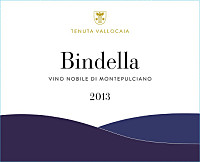
|
|
Vino Nobile di Montepulciano 2013 |
|
| Bindella (Tuscany, Italy) | |
 Sangiovese (85%), Colorino del Valdarno, Canaiolo Nero, Mammolo (15%) Sangiovese (85%), Colorino del Valdarno, Canaiolo Nero, Mammolo (15%) | |
| Price: € 17.00 | Score: |
 Brilliant ruby red and nuances of garnet red, moderate transparency. Brilliant ruby red and nuances of garnet red, moderate transparency. Intense, clean, pleasing and refined, starts with hints of black
cherry, plum and raspberry followed by aromas of violet, blueberry,
strawberry, rose, tobacco, chocolate, pink pepper and menthol. Intense, clean, pleasing and refined, starts with hints of black
cherry, plum and raspberry followed by aromas of violet, blueberry,
strawberry, rose, tobacco, chocolate, pink pepper and menthol.
 Tannic attack and however balanced by alcohol, full body, intense
flavors, pleasing crispness. Tannic attack and however balanced by alcohol, full body, intense
flavors, pleasing crispness.
 Persistent finish with flavors of black cherry, plum and raspberry. Persistent finish with flavors of black cherry, plum and raspberry. 22 months in cask, 6 months in bottle. 22 months in cask, 6 months in bottle. |
|
 Game, Roasted meat, Stewed and braised meat, Hard cheese Game, Roasted meat, Stewed and braised meat, Hard cheese |
|
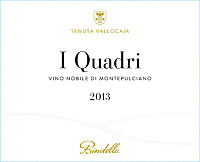
|
|
Vino Nobile di Montepulciano I Quadri 2013 |
|
| Bindella (Tuscany, Italy) | |
 Sangiovese Sangiovese | |
| Price: € 25.00 | Score: |
 Intense ruby red and nuances of ruby red, little transparency. Intense ruby red and nuances of ruby red, little transparency. Intense, clean, pleasing, refined and elegant, starts with hints of
black cherry, plum and violet followed by aromas of raspberry, blueberry,
blackberry, vanilla, chocolate, pink pepper, tobacco, mace and cinnamon. Intense, clean, pleasing, refined and elegant, starts with hints of
black cherry, plum and violet followed by aromas of raspberry, blueberry,
blackberry, vanilla, chocolate, pink pepper, tobacco, mace and cinnamon.
 Tannic attack and however balanced by alcohol, full body, intense
flavors, pleasing crispness. Tannic attack and however balanced by alcohol, full body, intense
flavors, pleasing crispness.
 Very persistent finish with long flavors of black cherry, plum and
raspberry. Very persistent finish with long flavors of black cherry, plum and
raspberry.
 20 months in cask, 12 months in bottle. 20 months in cask, 12 months in bottle. |
|
 Game, Roasted meat, Stewed and braised meat, Hard cheese Game, Roasted meat, Stewed and braised meat, Hard cheese |
|

|
|
Aglianico del Vulture Titolo 2014 |
|
| Elena Fucci (Basilicata, Italy) | |
 Aglianico Aglianico | |
| Price: € 30.00 | Score: |
 Intense ruby red and nuances of ruby red, little transparency. Intense ruby red and nuances of ruby red, little transparency. Intense, clean, pleasing, refined and elegant, starts with hints of
black cherry, blackberry and plum followed by aromas of blueberry, violet,
carob, black currant, vanilla, chocolate, tobacco, mace, rosemary and
menthol. Intense, clean, pleasing, refined and elegant, starts with hints of
black cherry, blackberry and plum followed by aromas of blueberry, violet,
carob, black currant, vanilla, chocolate, tobacco, mace, rosemary and
menthol.
 Tannic attack and however balanced by alcohol, full body, intense
flavors, pleasing crispness. Tannic attack and however balanced by alcohol, full body, intense
flavors, pleasing crispness.
 Very persistent finish with long flavors of black cherry, blackberry,
blueberry and plum. Very persistent finish with long flavors of black cherry, blackberry,
blueberry and plum.
 12 months in barrique, 12 months in bottle. 12 months in barrique, 12 months in bottle. |
|
 Game, Roasted meat, Stewed and braised meat, Hard cheese Game, Roasted meat, Stewed and braised meat, Hard cheese |
|

|
|
Maximo 2013 |
|
| Umani Ronchi (Marches, Italy) | |
 Sauvignon Blanc Sauvignon Blanc | |
| Price: € 15.80 - 375ml | Score: |
 Brilliant amber yellow and nuances of amber yellow, transparent. Brilliant amber yellow and nuances of amber yellow, transparent. Intense, clean, pleasing, refined and elegant, starts with hints of
raisin, dried apricot, lychee and honey followed by aromas of candied
fruits, dried fig, quince jam, melon, pear jam, date, peach jam, citrus
fruit peel, saffron and cedar. Intense, clean, pleasing, refined and elegant, starts with hints of
raisin, dried apricot, lychee and honey followed by aromas of candied
fruits, dried fig, quince jam, melon, pear jam, date, peach jam, citrus
fruit peel, saffron and cedar.
 Sweet and round attack, however balanced by alcohol, good body, intense
flavors, pleasing crispness. Sweet and round attack, however balanced by alcohol, good body, intense
flavors, pleasing crispness.
 Very persistent finish with long flavors of raisin, dried apricot and
candied fruits. Very persistent finish with long flavors of raisin, dried apricot and
candied fruits.
 12 months in steel tanks. 12 months in steel tanks. |
|
 Confectionery, Hard cheese Confectionery, Hard cheese |
|

|
|
Conero Riserva Campo San Giorgio 2011 |
|
| Umani Ronchi (Marches, Italy) | |
 Montepulciano Montepulciano | |
| Price: € 40.00 | Score: |
 Intense ruby red and nuances of garnet red, little transparency. Intense ruby red and nuances of garnet red, little transparency. Intense, clean, pleasing, refined and elegant, starts with hints of
black cherry, plum and blackberry followed by aromas of violet, blueberry,
chocolate, black currant, tobacco, vanilla, leather, face powder, licorice,
mace and menthol. Intense, clean, pleasing, refined and elegant, starts with hints of
black cherry, plum and blackberry followed by aromas of violet, blueberry,
chocolate, black currant, tobacco, vanilla, leather, face powder, licorice,
mace and menthol.
 Tannic attack and however balanced by alcohol, full body, intense
flavors, agreeable. Tannic attack and however balanced by alcohol, full body, intense
flavors, agreeable.
 Very persistent finish with long flavors of black cherry, plum and
blackberry. Very persistent finish with long flavors of black cherry, plum and
blackberry.
 12 months in barrique, 6 months in cask, 10 months in bottle. 12 months in barrique, 6 months in cask, 10 months in bottle. |
|
 Game, Roasted meat, Braised and stewed meat, Hard cheese Game, Roasted meat, Braised and stewed meat, Hard cheese |
|
News |
|
In this section are published news and information about events concerning the world of wine and food. Whoever is interested in publishing this kind of information can send us a mail to our address.
|
AquavitaeReview of Grappa, Distillates and Brandy |
|
|
||||||||||||
Wine Guide ParadeNovember 2016
|
| |||||||
Privacy Policy | |||||||


| Copyright © 2002-2024 Antonello Biancalana, DiWineTaste - All rights reserved |
| All rights reserved under international copyright conventions. No part of this publication and of this WEB site may be
reproduced or utilized in any form or by any means, electronic or mechanical, without permission in writing from DiWineTaste. |